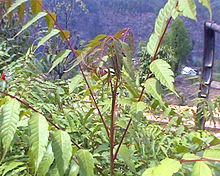From Wikipedia, the
free encyclopedia
Choerospondias axillaris, known as Lapsi ("candy tree") in Nepal and 南酸枣 in Mandarin (nan2 suan1 zao3), is a tree in the family Anacardiaceae. It is native to much of Asia from China to India to Japan. Its fruit is about 3 centimeters long and has a a soft whitish sour flesh and green to yellow skin. The fruit is made into pickles, fruit tarts, and sour, spicy candy in Nepal. The tree has long been cultivated in rural Nepal for its fruit.[1] The fruit is nutritious and has a price comparable to the mandarin orange on the Nepalese market.[1]
This is a deciduous tree growing up to 20 meters tall. The smaller branches are purple-brown in color. The compound leaves are up to 40 centimeters long and divided into 3 to 6 papery oval leaflets each up to 12 by 4.5 centimeters. The tree is dioecious, with male and female trees producing different types of inflorescence. Male flowers occur in long clusters and have curving, brown-veined petals about 3 millimeters long. Female flowers are solitary in leaf axils at the tips of branches. They are larger than the male flowers and yield the edible drupe.
Besides fruit, the tree yields valuable wood and hard seeds which are burned for fuel, and has parts used medicinally in Vietnam.[1]
[edit] References
[edit] External links
This article incorporates text from the public domain 1907 edition of The Nuttall Encyclopædia.



 , lapsi bhaneko English ma k bhanchha bhanera dikka pari sakyo. Taha chha kasailai name and any description links?
, lapsi bhaneko English ma k bhanchha bhanera dikka pari sakyo. Taha chha kasailai name and any description links?

 , thats what he might be looking for, not the morphology
, thats what he might be looking for, not the morphology 

 Nepali Botanist le naya category banaunu paryo.
Nepali Botanist le naya category banaunu paryo. 





